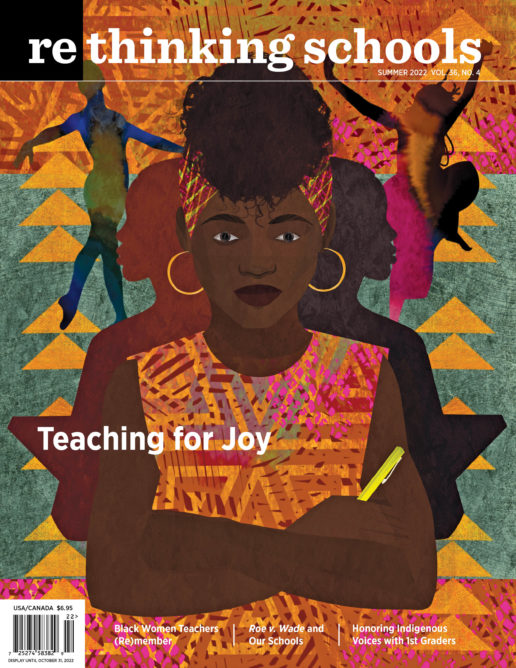The Disempowering Impact of the Little People, BIG DREAMS Series
Illustrator: Boris Séméniako

Enter the children’s section in any bookstore or library and you are bound to see a display of titles from theLittle People, BIG DREAMS picture book series. Written for very young readers, they include titles on a range of activists, religious leaders, artists, and entertainers.
Their stated purpose is to “introduce children to historical and contemporary dreamers who made an impact in the world.” With heroes we all recognize and a catchy series title, they are also a popular gift for young children. Sadly, the titles my colleagues and I at Teaching for Change examined present a one-dimensional, pop-cultural conception of key figures, reinforcing stereotypes and disregarding their strides as part of a collective effort.
Each book in the series follows the same story arc, starting from the figure’s childhood up until the One Contribution they’ve made in society. As a result, children receive a fragmented overview of the person’s life, racked with generalizations and tokenism. For example, in the book on Martin Luther King Jr., the story’s climax is King’s speech at the March on Washington for Jobs and Freedom. The book ends with an excerpt from King’s speech that the Right frequently uses when they attack contemporary social justice activists: “. . . dream of a world where we are judged by our character, not by the color of our skin.” The book regurgitates the common trope of King as a peaceful and dreamy activist with its emphasis on Mahatma Gandhi being King’s inspiration and his winning of the Nobel Peace Prize, without also acknowledging that King believed in radical transformation. In his April 1967 “Beyond Vietnam” speech, King said, “Our only hope today lies in our ability to recapture the revolutionary spirit and go out into a sometimes hostile world declaring eternal hostility to poverty, racism, and militarism.”
As a result, children receive a fragmented overview of the person’s life, racked with generalizations and tokenism.
Similarly, in the book on Rosa Parks, the climax of the story is when Parks refuses to give up her seat to a white man on the bus, inspiring the Montgomery Bus Boycott. Although this event is what made Parks a public figure, it was not her first act of resistance on a bus, nor her activist beginning. The book mentions that prior to this event, Parks started working “to get more rights for Black people and help for those who were treated badly,” which is only an abstraction of the extensive civil rights work Parks was dedicated to for decades before and after her stance on the bus. Parks lived more than half her life in Detroit, where she continued her social justice activism, but children would not know this from the Little People, BIG DREAMS book.
There is also a “first of” or “only one” message in the Little People, BIG DREAMS series that is inaccurate and misleads young readers about social change. For example, the book on Greta Thunberg ends with “What started with just one girl with a handmade sign became a movement that includes us all. Global warming is the greatest challenge humanity will ever face, but little Greta is no longer alone.” While Thunberg deserves praise for her relentless activism, she wasn’t the first to demand action, but instead is a part of a long line of people and groups who have fought for environmental and climate justice around the world, a fact not included in her story. It was those groups who turned out for Fridays for Future — that mobilization did not happen in a vacuum and it is disempowering for young people to learn that it did. By placing Thunberg on a pedestal — against her own wishes — the author erases the decades of work of activists of color. In addition, it can be argued that climate change is one of the greatest challenges humanity faces alongside many other systemic issues, all of which link to the climate emergency.
Libraries and bookstores should discontinue their active promotion of this series that appears to dedicate more resources to marketing than to researching and writing effective stories about social change for young people.
Libraries and bookstores should discontinue their active promotion of this series that appears to dedicate more resources to marketing than to researching and writing effective stories about social change for young people.
When choosing texts for children about major historical and contemporary figures, it’s important for adults to ensure that it provides an accurate and age-appropriate depiction — and seek to avoid instilling in young children the individual hero narrative that becomes hard to undo in later years. Through conversations and books such as Swimmy by Leo Lionni and One by Kathryn Otoshi, we can introduce young children to the power of collective action. If young people ask specifically about the Civil Rights Movement, a few to consider are We March by Shane Evans, Rosa by Nikki Giovanni, Child of the Civil Rights Movement by Paula Young Shelton, and Freedom on the Menu by Carole Boston Weatherford.
Yes, Dr. King, Rosa Parks, and Greta Thunberg are among many people who have fought to make things fair for everyone, in the past and today. As we read to and talk with young children, it is important that we highlight collective efforts for change.
For books we do recommend, see our Summer 2022 picks for books, videos, websites, and other social justice resources.
Want more content like this? Subscribe now to Rethinking Schools! A one-year subscription is just $24.95 and helps support our efforts to provide antiracist and social justice curriculum and articles for educators everywhere.

